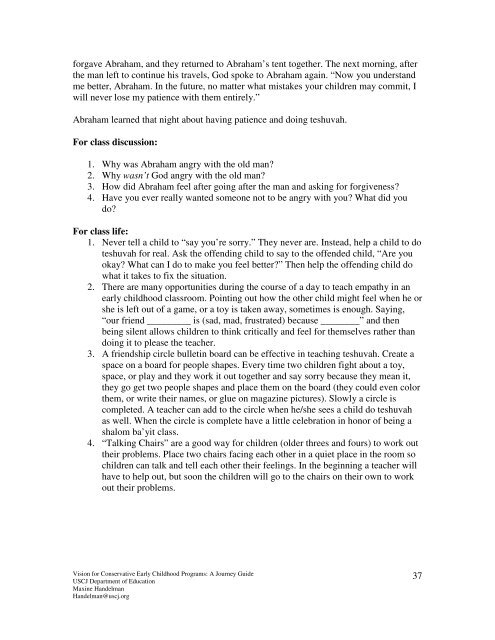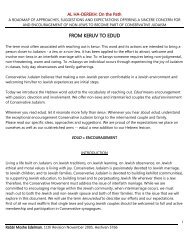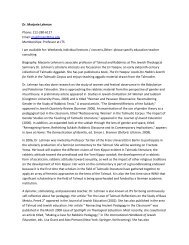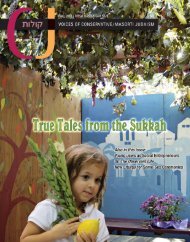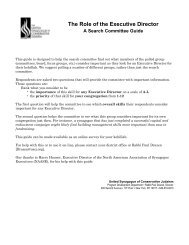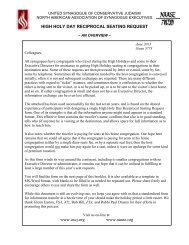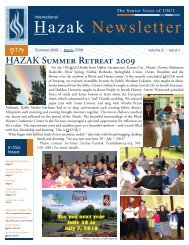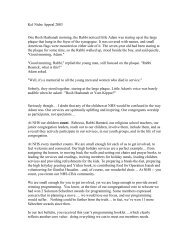Vision for Conservative Early Childhood Programs: A Journey Guide
Vision for Conservative Early Childhood Programs: A Journey Guide
Vision for Conservative Early Childhood Programs: A Journey Guide
You also want an ePaper? Increase the reach of your titles
YUMPU automatically turns print PDFs into web optimized ePapers that Google loves.
<strong>for</strong>gave Abraham, and they returned to Abraham’s tent together. The next morning, after<br />
the man left to continue his travels, God spoke to Abraham again. “Now you understand<br />
me better, Abraham. In the future, no matter what mistakes your children may commit, I<br />
will never lose my patience with them entirely.”<br />
Abraham learned that night about having patience and doing teshuvah.<br />
For class discussion:<br />
1. Why was Abraham angry with the old man?<br />
2. Why wasn’t God angry with the old man?<br />
3. How did Abraham feel after going after the man and asking <strong>for</strong> <strong>for</strong>giveness?<br />
4. Have you ever really wanted someone not to be angry with you? What did you<br />
do?<br />
For class life:<br />
1. Never tell a child to “say you’re sorry.” They never are. Instead, help a child to do<br />
teshuvah <strong>for</strong> real. Ask the offending child to say to the offended child, “Are you<br />
okay? What can I do to make you feel better?” Then help the offending child do<br />
what it takes to fix the situation.<br />
2. There are many opportunities during the course of a day to teach empathy in an<br />
early childhood classroom. Pointing out how the other child might feel when he or<br />
she is left out of a game, or a toy is taken away, sometimes is enough. Saying,<br />
“our friend _________ is (sad, mad, frustrated) because ________” and then<br />
being silent allows children to think critically and feel <strong>for</strong> themselves rather than<br />
doing it to please the teacher.<br />
3. A friendship circle bulletin board can be effective in teaching teshuvah. Create a<br />
space on a board <strong>for</strong> people shapes. Every time two children fight about a toy,<br />
space, or play and they work it out together and say sorry because they mean it,<br />
they go get two people shapes and place them on the board (they could even color<br />
them, or write their names, or glue on magazine pictures). Slowly a circle is<br />
completed. A teacher can add to the circle when he/she sees a child do teshuvah<br />
as well. When the circle is complete have a little celebration in honor of being a<br />
shalom ba’yit class.<br />
4. “Talking Chairs” are a good way <strong>for</strong> children (older threes and fours) to work out<br />
their problems. Place two chairs facing each other in a quiet place in the room so<br />
children can talk and tell each other their feelings. In the beginning a teacher will<br />
have to help out, but soon the children will go to the chairs on their own to work<br />
out their problems.<br />
<strong>Vision</strong> <strong>for</strong> <strong>Conservative</strong> <strong>Early</strong> <strong>Childhood</strong> <strong>Programs</strong>: A <strong>Journey</strong> <strong>Guide</strong><br />
USCJ Department of Education<br />
Maxine Handelman<br />
Handelman@uscj.org<br />
37


